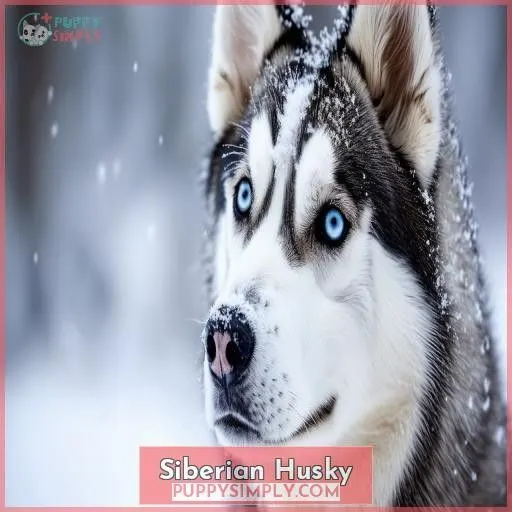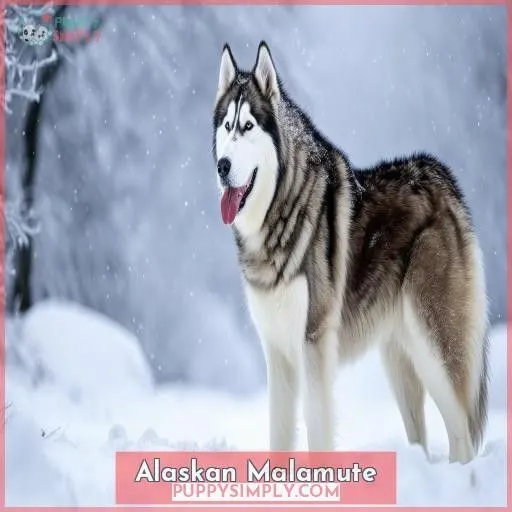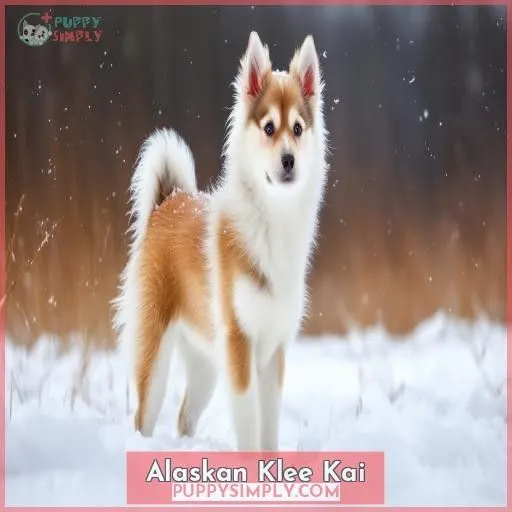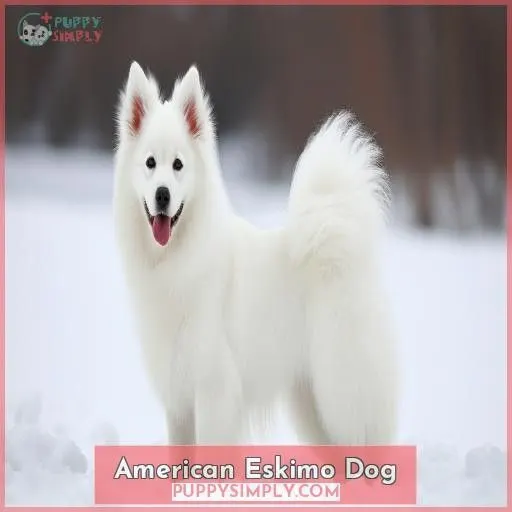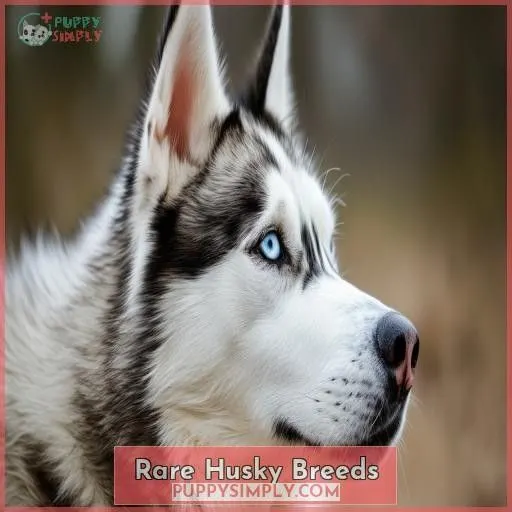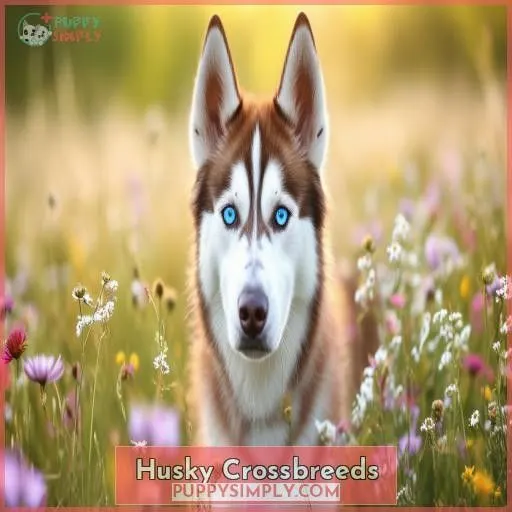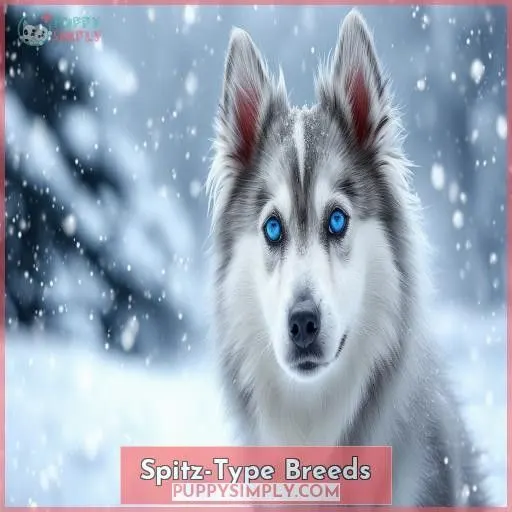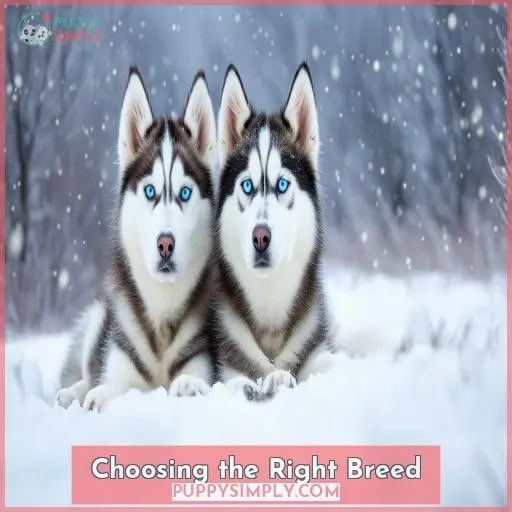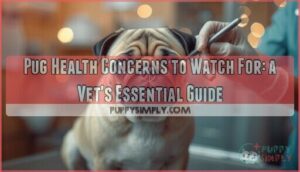This site is supported by our readers. We may earn a commission, at no cost to you, if you purchase through links.
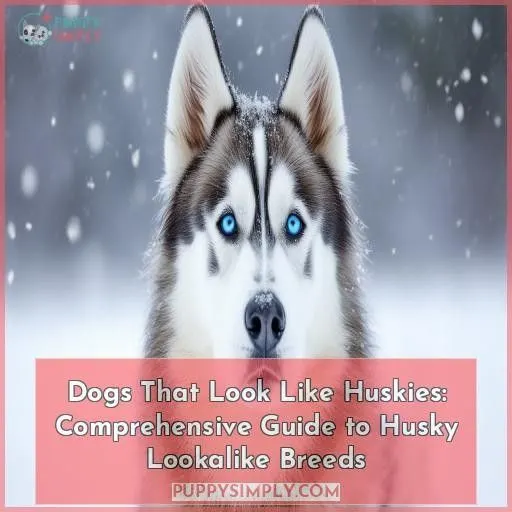 If you’re fascinated by the striking appearance of the Siberian Husky, you’ll be delighted to know that several breeds resemble these majestic dogs.
If you’re fascinated by the striking appearance of the Siberian Husky, you’ll be delighted to know that several breeds resemble these majestic dogs.
The Alaskan Malamute, larger and bolder, shares a similar thick coat.
The miniature Alaskan Klee Kai and the fluffy Samoyed also boast husky-like features.
Don’t overlook the American Eskimo Dog, available in three sizes, from toy to standard.
While each breed has unique characteristics, their resemblance to huskies is undeniable.
Intrigued? Let’s explore these captivating lookalikes in greater depth.
Table Of Contents
- Key Takeaways
- Siberian Husky
- Alaskan Malamute
- Alaskan Klee Kai
- Samoyed
- American Eskimo Dog
- Rare Husky Breeds
- Husky Crossbreeds
- Spitz-Type Breeds
- Choosing the Right Breed
- Frequently Asked Questions (FAQs)
- What breed of dog looks like a Husky?
- What kind of dog looks like a Husky but stay small?
- Are Alaska Malamutes bigger than Huskies?
- How much does a Klee Kai cost?
- How do their grooming needs compare?
- Which breeds are best for apartments?
- What are their typical life spans?
- How do their barking/vocalizing tendencies differ?
- Which breeds are best with children?
- Conclusion
Key Takeaways
- Brace yourself for a thrilling adventure into the captivating world of Husky lookalikes – from the majestic Alaskan Malamute to the fluffy Samoyed and the compact Alaskan Klee Kai, each breed promises a unique and delightful experience.
- Prepare to be enchanted by their striking similarities yet distinct personalities, ranging from the vocal and social Siberian Husky to the more reserved and independent Alaskan Malamute, ensuring there’s a perfect match for every potential dog owner.
- Embrace the challenge of finding the ideal balance between their exercise demands, grooming needs, and temperaments – a task as rewarding as conquering the Arctic tundra, where many of these breeds trace their ancestral roots.
- Unleash your sense of adventure and open your heart to the possibility of welcoming one of these mesmerizing canine companions into your life, for they promise to bring joy, unconditional love, and a touch of wilderness into your home.
Siberian Husky
When you think of a Siberian Husky, imagine a medium-sized, social dog with striking blue eyes, often recognized for their friendly temperament and high intelligence.
Huskies are known for their thick double coat, which sheds profusely, especially during seasonal changes. They originate as Arctic sled-pulling dogs, sharing ancestry with the Alaskan Malamute but are distinct in several ways. Unlike Malamutes, Siberian Huskies are more vocal, using a range of howls and whines to communicate. They also tend to have a more defined mask-like facial marking and a lighter body frame.
This breed’s intelligence demands regular exercise and mental challenges to keep them happy and well-behaved.
Alaskan Malamute
When comparing the Alaskan Malamute and the Siberian Husky, you’ll immediately notice that Malamutes are larger, heavier, and exhibit bolder coloring. Additionally, Malamutes tend to be more independent and require experienced owners, making them less suitable for first-time dog owners .
Physical Differences
When comparing Alaskan Malamutes to Siberian Huskies, notable physical differences include:
- Size variations: Malamutes are larger, often weighing double the amount of a Husky .
- Eye color: Malamutes typically have brown eyes, whereas Huskies may have blue or heterochromatic eyes .
- Tail shape: Malamutes have a curled tail, unlike the straight or slightly curved tail of a Husky .
Temperament Differences
Alaskan Malamutes, distinctive among husky lookalike breeds, are known for their strong pack behavior and high prey drive. Unlike Siberian Huskies, they exhibit less vocalization but can display more aggression. Their independence gives them a wolf-like appearance, while they’re also prone to separation anxiety if left alone for extended periods. Understanding these temperament differences is critical.
| Trait | Alaskan Malamute | Siberian Husky |
|---|---|---|
| Pack Behavior | Strong | Moderate |
| Prey Drive | High | Medium |
| Vocalization | Low | High |
Alaskan Klee Kai
Moving on from the Alaskan Malamute, let’s explore the enchanting Alaskan Klee Kai. This miniature Husky breed is ideal for those who love the appearance of Huskies but prefer a smaller, more manageable companion.
The Alaskan Klee Kai is a purebred working dog, often likened to Siberian Huskies but with unique characteristics. They thrive in apartments, require moderate exercise, and are known for their vocal tendencies. This breed isn’t hypoallergenic.
- Size: Compact, perfect for apartment living.
- Exercise Needs: Enjoy participating in agility courses and outdoor activities.
- Personality: Intelligent, curious, and somewhat reserved with strangers.
- Coat: Requires regular grooming to maintain.
- Vocalization: Expressive and communicative, often vocalizing with their owners.
Samoyed
The Samoyed, known for its thick, white or creamy coat, shares a similar build and dense fur with the Siberian Husky . These dogs are friendly and loyal, making them excellent companions but aren’t ideal for hot climates due to their thick coats .
Coat Characteristics
Samoyeds are characterized by thick double coats, often regal in appearance. Their coats are dense, with a soft and woolly undercoat and a longer, harsher outer coat. Typically white or creamy, these coats lack color variations like black or brown markings. Shedding habits are seasonal, requiring regular grooming to manage their lush, bushy tails and erect ears .
Personality Traits
Samoyeds, one of the husky lookalike breeds, display exceptional intelligence and affectionate nature, making them highly trainable. They boast high socialization needs and independence, similar to Siberian Huskies and Alaskan Malamutes. Unlike the more reserved Akita Inu, Samoyeds are friendly and loyal, thriving in environments where they receive consistent attention and mental stimulation .
American Eskimo Dog
The American Eskimo Dog, resembling a Husky but smaller, comes in three sizes: Standard, Miniature, and Toy. This intelligent and friendly breed requires moderate exercise and grooming, making it a popular choice for various living environments .
Standard Size
The American Eskimo Dog, standard size, is an intelligent, attached companion, with significant training challenges and health concerns like hip dysplasia and progressive retinal atrophy. Their history traces back to German Spitz roots. Nutrition-wise, they thrive on balanced diets to support their active temperament, similar to Siberian Huskies, Alaskan Malamutes, Samoyeds, Keeshonds, and Norwegian Elkhounds (Source).
Miniature and Toy Sizes
Following standard-sized Eskimos, the miniature and toy American Eskimo Dogs are perfect for apartment living. These small, compact dogs, being hypoallergenic, require low exercise. Ideal for first-time owners, their friendly and intelligent nature fits well in small spaces, ensuring you can maintain a happy, active, and safe environment for your apartment lifestyle (Source).
Rare Husky Breeds
Exploring rare Husky breeds, you’ll find the White Husky, Sakhalin Husky, and Mackenzie River Husky, each presenting unique characteristics. These breeds are distinguished by their physical traits, endurance abilities, and historical significance, making them fascinating subjects of study .
White Husky
The White Husky, a rare variation of the Siberian Husky, is known for its pure, white, or creamy coat and piercing blue eyes. As an arctic breed, these dogs possess wolf-like features, require extensive exercise, and have unique genetic traits. When considering white husky adoption or care, make sure to connect with reputable breeders for best health .
Sakhalin Husky
The Sakhalin Husky, a nearly extinct sled dog from Japan, faces significant breeding challenges and conservation efforts.
With a history deeply influenced by Japanese culture, this breed is known for its remarkable endurance in Arctic conditions.
Genetic diversity within Sakhalin Huskies is limited, necessitating strategic efforts to preserve these resilient dogs, which are closely related to Siberian and Alaskan sled dogs .
Mackenzie River Husky
The Mackenzie River Husky, like a sled dog from a bygone era, boasts a large, robust frame and wolf-like features. Known for their independent nature, these dogs require experienced owners. Grooming involves regular brushing of their thick, double coat to prevent matting. They possess a strong-willed temperament, demanding consistent training and ample exercise, reflecting their historic sled-pulling heritage .
Husky Crossbreeds
In the ‘Husky Crossbreeds’ section, you’ll explore fascinating hybrids such as the Labrador Husky, combining friendly, high-energy traits, and the Shepsky, noted for its athleticism and need for mental stimulation . The Pomeranian Husky, or Pomsky, stands out for its playful intelligence and independence, requiring early socialization to thrive .
Labrador Husky
If you’re considering a Labrador Husky, you’ll find they combine the best traits of both breeds. They’re large, energetic dogs, needing ample space and exercise to thrive . Their friendly temperament makes them wonderful companions, but they require consistent training, especially in harsh climates like Siberia .
- High energy levels
- Friendly and social
- Great with families
Shepsky
The Shepsky, with a wolf-like appearance, combines the intelligence of a German Shepherd with the friendly, energetic nature of a Siberian Husky. Ideal for families, they exhibit exceptional beauty and adaptability. However, make certain they’ve plenty of exercise and mental stimulation.
| Height | Weight | Lifespan | Traits | |
|---|---|---|---|---|
| Shepsky | 20-25 inches | 45-88 pounds | 10-14 years | Friendly, Intelligent |
| Siberian Husky | 20-24 inches | 35-60 pounds | 12-14 years | Energetic, Social |
| German Shepherd | 22-26 inches | 50-90 pounds | 9-13 years | Loyal, Intelligent |
| Samoyed | 19-23.5 inches | 50-65 pounds | 12-14 years | Friendly, Loyal |
Pomeranian Husky
The Pomeranian Husky, or Pomsky, is small, playful, and intelligent, combining the Pomeranian’s spirited nature with the Siberian Husky’s striking looks (Source). With intelligent eyes, a bushy tail, thick coat, and high-set ears, Pomskies need regular grooming and moderate exercise. They’re independent yet affectionate, thriving with early socialization for balanced temperament.
Spitz-Type Breeds
Among the spitz-type breeds that resemble huskies, the Keeshond stands out with its distinctive gray double coat, erect ears, and highly social demeanor, making it an excellent companion dog.
The Norwegian Elkhound and Japanese Akita Inu are known for their bold personalities. The former excels as a watchdog, while the latter is renowned for its loyalty and protective nature.
Keeshond
You’ll find the Keeshond, a lively, compact Spitz-type breed, hard to resist! With their:
- Dense gray coat requiring regular grooming
- Loud "bark" often used for communication
- Social nature needing proper socialization
The Keeshond makes a loyal, affectionate companion well-suited to apartment living if exercised sufficiently. Their permanently curled tails and fox-like expressions add to their appeal.
Norwegian Elkhound
The Norwegian Elkhound, another Spitz-type breed, shares similarities with Huskies. You’ll need to commit to regular grooming for their dense double coat. As an independent hunting companion, training requires patience—their strength and endurance make them excellent running partners. Though friendly, use caution when introducing them to other dogs initially.
Japanese Akita Inu
Speaking of spitz-type breeds, you can’t overlook the Japanese Akita Inu. This loyal, fearless guard dog has:
- A thick double coat that requires regular brushing
- A stubborn streak that necessitates firm, consistent training
- Thrives in temperate, comfortable climates
- Should only be acquired from reputable breeders
The Akita’s dignified bearing and protective nature make it a cherished companion for experienced owners.
Choosing the Right Breed
When selecting a Husky or Husky-like breed, carefully consider the exercise requirements, grooming needs, and temperament to verify compatibility with your lifestyle. While these breeds have similarities in appearance, their energy levels, coat maintenance demands, and personality traits can vary considerably, necessitating thorough research to make an informed decision.
Exercise Requirements
Now, let’s discuss the exercise requirements for husky-like breeds. These energetic dogs are exceptional athletes, with giant sizes and endurance like marathon runners. Their fur between toes aids smooth movements, so they need ample space to run and play. Consistent training methods that match their independent temperaments, along with proper socialization, are essential.
| Breed | Exercise Needs | Space Requirements |
|---|---|---|
| Siberian Husky | High | Large yard or frequent walks |
| Alaskan Malamute | Very High | Acres to roam |
| Samoyed | Moderate | Fenced yard |
Grooming Needs
Maintaining a Husky lookalike’s lush coat requires dedication. Be prepared for heavy shedding, necessitating regular brushing and de-shedding tools like:
- Slicker brushes
- Undercoat rakes
- De-shedding combs
- Vacuum with strong suction
Bathing is minimal, but a hypoallergenic shampoo prevents dry skin and residue buildup. With the right grooming routine, you’ll keep their striking coat pristine.
Temperament Considerations
Once you’ve considered grooming needs, it’s essential to evaluate temperament – how stranger-friendly, independent, and vocal each breed is. Huskies adore company but can be escape artists. Other Spitz breeds like Akitas make excellent watchdogs but are more aloof. Playful companions like the Klee Kai still mimic Huskies’ famous "woo woo" sound from their sled dog heritage.
Frequently Asked Questions (FAQs)
What breed of dog looks like a Husky?
You’ll swear it’s a Husky, but the Alaskan Malamute’s larger size and bolder coloring will shock you! These wolf-like Arctic sled dogs share striking similarities.
What kind of dog looks like a Husky but stay small?
You’re looking for a small, Husky-like dog? Check out the Alaskan Klee Kai – a miniature version bred to resemble Siberian Huskies. While tiny, they share the Husky’s striking looks, friendly nature, and boundless energy.
Are Alaska Malamutes bigger than Huskies?
Yes, Alaskan Malamutes are considerably larger and heavier than Siberian Huskies. These powerful sled dogs possess an imposing wolf-like stature, weighing up to 85 lbs compared to a Husky’s 45-60 lbs.
How much does a Klee Kai cost?
Like finding a gem on Arctic terrain, the Klee Kai‘s cost reflects its rarity – around $1,500 to $3,500 for this miniature Husky lookalike. Prepare for an energetic, clever companion requiring ample exercise and training.
How do their grooming needs compare?
Their grooming needs are similar – they all require weekly brushing to manage their thick double coats and occasional bathing. Proper coat care prevents matting and excess shedding around your home.
Which breeds are best for apartments?
For apartments, smaller breeds like the Alaskan Klee Kai or American Eskimo Dog (Mini/Toy varieties) are ideal, requiring less exercise while thriving in compact spaces with early training and socialization.
What are their typical life spans?
As the adage goes, knowledge brings growth. Typically, huskies have a life expectancy of 12-15 years when well-cared for, though some may live longer with proper exercise, nutrition, and veterinary care. Their longevity allows ample time for fulfilling companionship.
How do their barking/vocalizing tendencies differ?
Huskies are renowned for their vocal, howling tendencies, while breeds like Akitas and Samoyeds are generally more reserved barkers. Malamutes bark less frequently but with a louder, deeper tone. Understanding their vocalizing habits helps manage expectations as an owner.
Which breeds are best with children?
With over 50% being family-friendly, huskies can make great companions for children. Key is proper socialization and training – patient owners willing to channel their high energy into positive outlets will be rewarded with loyal, loving furry friends.
Conclusion
Akin to a kaleidoscopic prism, the world of husky-like canines unfurls a captivating array of breeds, each with its unique charm.
Your exploration into these husky lookalikes should be guided by a careful evaluation of exercise requirements, grooming needs, and temperament considerations to find a harmonious companion for your lifestyle.
Embrace the journey and let your heart resonate with the breed that resonates most profoundly.

